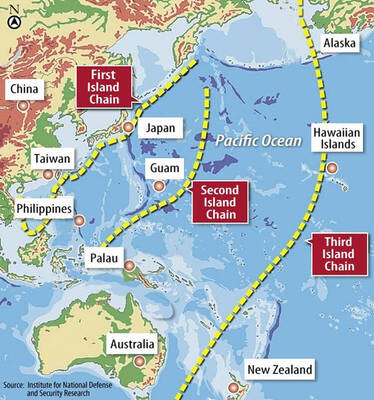Academia Sinica yesterday cut its forecast for this year’s GDP growth to 1.94 percent from a previous estimate of 3.81 percent made in December last year, citing sluggish momentum on exports as a result of global economic uncertainty, which may further impact domestic demand.
The latest forecast from the nation’s top research institute was the weakest among all domestic think tanks and it was also lower than the 3.03 percent growth forecast issued by the Directorate-General of Budget, Accounting and Statistics (DGBAS) in May.
The DGBAS is scheduled to update its forecast on July 31.
“Worse-than-expected international trade was the main adjustment in this revision, because world outlook and global trade activity remain very weak and uncertain,” Ray Chou (周雨田), an economic research fellow at Academia Sinica, told a press conference.
Exports fell 4.7 percent from a year ago in the first six months, marking one of the worst performances among countries in Asia, with exports to the US, Europe, China and Hong Kong all slowing down.
The lingering global economic uncertainty also prompted Academia Sinica to cut its growth forecast for the output sector to 0.87 percent this year from the 5.15 percent estimate it made in December last year.
Chou said sluggish external demand would further affect domestic demand and weaken the investment intentions of domestic firms, especially capital investment on equipment. The institute therefore revised down its growth forecast for private investment to minus-0.5 percent this year, from 2.2 percent previously.
Academia Sinica also adjusted downward its growth forecast for private consumption this year from 2.72 percent to 2.1 percent, as the government’s move to raise energy prices and a worsening stock market performance dampened consumer spending in the second quarter.
The institute forecast annual growth in headline inflation at 1.8 percent this year, up from the 1.16 percent it estimated previously.
Academia Sinica expects the economy to contract 0.89 percent from a year earlier in the second quarter, but to rebound with 2.72 percent growth and 5.29 percent growth in the third and fourth quarters respectively on the back of a lower base.
Peng Shin-kun (彭信坤), director of Academia Sinica’s Institute of Economics, said it was almost a “mission impossible” for the nation’s economy to grow more than 3 percent this year.
However, Hung Jui-bin (洪瑞彬), director-general of the Council for Economic Planning and Development’s economic research department, said the institute’s forecast was too pessimistic.
Despite both external and internal uncertainties increasing more than previously expected, Hung said the government has been launching various short-term and long-term projects to stimulate growth in exports, investment and consumption, and that it is hoping to see positive effects very soon.

The US government has signed defense cooperation agreements with Japan and the Philippines to boost the deterrence capabilities of countries in the first island chain, a report by the National Security Bureau (NSB) showed. The main countries on the first island chain include the two nations and Taiwan. The bureau is to present the report at a meeting of the legislature’s Foreign Affairs and National Defense Committee tomorrow. The US military has deployed Typhon missile systems to Japan’s Yamaguchi Prefecture and Zambales province in the Philippines during their joint military exercises. It has also installed NMESIS anti-ship systems in Japan’s Okinawa

‘WIN-WIN’: The Philippines, and central and eastern European countries are important potential drone cooperation partners, Minister of Foreign Affairs Lin Chia-lung said Minister of Foreign Affairs Lin Chia-lung (林佳龍) in an interview published yesterday confirmed that there are joint ventures between Taiwan and Poland in the drone industry. Lin made the remark in an exclusive interview with the Chinese-language Liberty Times (the Taipei Times’ sister paper). The government-backed Taiwan Excellence Drone International Business Opportunities Alliance and the Polish Chamber of Unmanned Systems on Wednesday last week signed a memorandum of understanding in Poland to develop a “non-China” supply chain for drones and work together on key technologies. Asked if Taiwan prioritized Poland among central and eastern European countries in drone collaboration, Lin

The Chien Feng IV (勁蜂, Mighty Hornet) loitering munition is on track to enter flight tests next month in connection with potential adoption by Taiwanese and US armed forces, a government source said yesterday. The kamikaze drone, which boasts a range of 1,000km, debuted at the Taipei Aerospace and Defense Technology Exhibition in September, the official said on condition of anonymity. The Chungshan Institute of Science and Technology and US-based Kratos Defense jointly developed the platform by leveraging the engine and airframe of the latter’s MQM-178 Firejet target drone, they said. The uncrewed aerial vehicle is designed to utilize an artificial intelligence computer

Renewed border fighting between Thailand and Cambodia showed no signs of abating yesterday, leaving hundreds of thousands of displaced people in both countries living in strained conditions as more flooded into temporary shelters. Reporters on the Thai side of the border heard sounds of outgoing, indirect fire yesterday. About 400,000 people have been evacuated from affected areas in Thailand and about 700 schools closed while fighting was ongoing in four border provinces, said Thai Rear Admiral Surasant Kongsiri, a spokesman for the military. Cambodia evacuated more than 127,000 villagers and closed hundreds of schools, the Thai Ministry of Defense said. Thailand’s military announced that